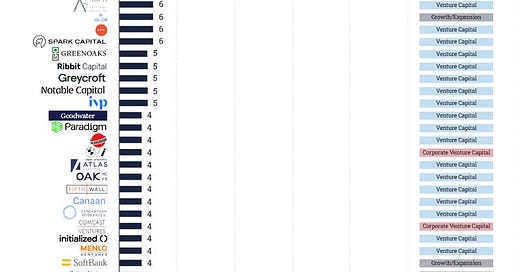Which investors are consistently spotting billion-dollar companies before anyone else?
New research from Stanford Professor Ilya Strebulaev analyzed more than 1,200 unicorns founded after 2015 and identified the VC firms that most often led early-stage rounds in companies that eventually reached $1B+ valuations.
The findings offer more than just a leaderboard—they highlight how power-law dynamics and early-stage conviction shape today’s venture outcomes.
🔑 Key Takeaways
1. Andreessen Horowitz Tops the List
With 39 early-stage lead investments in future unicorns, a16z is well ahead. Sequoia (24) and Lightspeed (20) follow. Newer entrants like Thrive Capital (10) signal that this ability isn’t limited to legacy firms.
2. Institutional VCs Dominate
Nearly all top spotters are traditional venture firms. Corporate VCs like GV (Google Ventures) are the exception, not the norm.
3. Early Leads Are Strategic Signals
It’s not just capital. These firms bring validation, access, and hiring magnetism.
“Getting these investors to lead your early rounds often may mean more than money – it’s a signal of validation that helps with hiring and future fundraising.”
4. Not All Unicorns Stay That Way
Roughly 330 of 1,200 unicorns studied have already taken down rounds and lost their $1B+ status. Chasing hype without substance remains a structural risk.
🔑 Key Findings
1. Hawk-eye VCs vs. Power of Volume
Sequoia has backed 134 unicorns, yielding an ~8% hit rate (based on ~1,669 portfolio companies)
Andreessen Horowitz has ~1,398 portfolio companies (specific unicorn count not listed), while Y Combinator (~5,586) and Plug and Play (~6,934) show the power of sheer volume.
2. Seed Odds Are Long—~0.5%
Only ~0.5% of seed-stage companies hit unicorn status, according to Stanford.
3. Early-Stage Specialists Crush the Market
Firms focusing on early-stage—such as Benchmark, SV Angel, Greylock—achieve 6–12% hit rates, significantly outperforming the baseline (0.5–2.5%).
4. Risk and Return Vary by Stage
Seed investments require 66–142× returns to reach unicorn status; late-stage bets need only 2.5–6×.
5. Unicorn Timelines
Most reach $1B valuation 3–8 years after founding, often within two rounds.
6. High Failure & Overvaluation Risk
~330 of 1,200+ unicorns have lost that status.
Stanford’s "fair value" analysis shows ~48% average overvaluation for reported unicorns.
💡 Why It Matters
For Founders:
Your first lead investor matters—far beyond valuation. These firms set the tone for governance, signaling, and future capital.
“The rare ones today back not just models, but missions.”
For Fund Managers:
Early-stage success isn’t just luck—it’s driven by:
• Conviction in underwritten theses
• Consistent sector or stage alignment
• Willingness to lead when uncertainty is highest
📌 Final Thought
A great early-stage investor does more than write the first check—they help build the architecture for what comes next. As Stanford’s data shows, that partnership—if chosen wisely—can be the single biggest predictor of breakout success.
📊 Full research and discussion from Professor Ilya Strebulaev, Stanford Graduate School of Business.
🛠 Tools to Navigate Small Fund Strategy
If you're an LP evaluating smaller GPs—or a fund manager sharpening your pitch—our premium toolkit was built to help you raise smarter, underwrite more clearly, and plan for real outcomes.
Each resource helps you model fund returns, benchmark DPI vs. carry, and visualize how small changes in structure impact outcomes for LPs and GPs.
Keep reading with a 7-day free trial
Subscribe to @TheFundCFO Newsletter to keep reading this post and get 7 days of free access to the full post archives.



